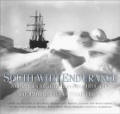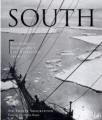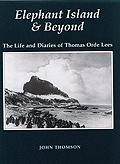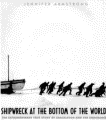John William Vincent, 1884 - 1941
Biographical notes
Able seaman Endurance 1914-17 - 35 at the start of the expedition

The Endurance Expedition
Vincent had been a sailor in the Royal Navy and was a former trawler hand on fishing boats on the North Sea. He was physically the strongest man aboard, and not beyond bullying his way around the ship. He began as bosun (boatswain), and seemed to think he could demonstrate his ability in this post by domination of the other crew members. There was a blazing row with Orde-Lees and several of the crew members reported Vincent to Shackleton for his bullying ways. Shackleton demoted him from boatswain to able seaman and it seems quite effectively put him in his place as there is little evidence of repeats of this behaviour after this incident, Shackleton remarked later how Vincent had "behaved himself" on the ice and in the boat to Elephant Island. The name "Bosun" however stuck as a nickname even after he had lost the post.
He did however openly side with McNish on the ice when McNish questioned Shackleton's authority to give orders once the Endurance had been lost.
Shackleton picked Vincent as one of the men for the journey in the James Caird to South Georgia, he was a good choice for his physical strength, but also Shackleton probably wanted him where he could keep an eye on him and also wanted him away from Elephant Island where morale would be difficult enough to maintain. The journey of the James Caird was particularly difficult for Vincent. He lost his upper lip when it became frozen the edge of a metal cup and his health deteriorated below that of the other men for reasons that didn't seem quite clear. By the time he reached South Georgia, he was in a very bad state.
Later on, back in England, Shackleton denied Vincent the Polar Medal, given to all but 4 of the expedition members.
Biography
John Vincent was born in Birmingham, England on the 24th of January 1884*. "From what've managed to gather is he probably started working on canal barges before serving a couple of years in the Navy and then ending up in Hull and into trawling."* (He didn't serve on HMS Cambridge, as often reported, this was a different John Vincent.)
The North Sea trawlers out of the port of Hull, operated in notoriously harsh conditions.
Vincent was a powerful man and had been a keen amateur boxer and wrestler.
"He settled in Hull because he met his first wife there."*
On return to England after the expedition, Vincent joined the merchant navy and was on a ship torpedoed in the Mediterranean Sea. After the war he returned back home to Hull working on trawlers and ships out of there and the neighbouring ports of Grimsby and Fleetwood. There was a short period where he worked for the Finnish Government in Finland as a pilot and fishing instructor, the Finns offered him the job on a permanent basis, but his wife didn't want to emigrate to Finland. Instead, they settled in Grimsby where they raised five sons and four daughters. Like many seafaring men he spent much time away from home and family.
He became captain of the fishing boats he served on and was known by his shipmates as "Sailor Jack". Almost everyone who came across him would mention his great physical presence and strength. He seems to have been thought of more kindly in later years than perhaps he was when on the Endurance.
In the Second World War, he enlisted in the Royal Naval Reserve and was given command of an armed trawler, H.M.Trawler "Alfredian" operating in the North Sea and East Coast.
He developed Pneumonia at sea and died in the Naval Hospital, Grimsby on Sunday 19th January 1941 at the age of 56, just 5 days shy of his 57th birthday.*
*Details corrected by Hayley Vincent Cropp, great granddaughter of John Vincent, March 2017.
References to John Vincent in Shackleton's book "South!" buy USA buy UK
- The camp I wished to find was one where the party could
live for weeks or even months in safety, without danger
from sea or wind in the heaviest winter gale. Wild was to
proceed westwards along the coast and was to take with him
four of the fittest men, Marston, Crean, Vincent,
and McCarthy. If he did not return before dark we were to
light a flare, which would serve him as a guide to the entrance
of the channel.
- I finally selected McNeish, McCarthy, and Vincent
in addition to Worsley and Crean. The crew seemed a strong
one, and as I looked at the men I felt confidence increasing.
The weather was fine on April 23, and we hurried forward
our preparations. It was on this day I decided finally that
the crew for the James Caird should consist of Worsley,
Crean, McNeish, McCarthy, Vincent, and myself.
- The swell made things difficult. Many of us got wet
to the waist while dragging the boat out Âa serious matter
in that climate. When the James Caird was afloat in the
surf she nearly capsized among the rocks before we could
get her clear, and Vincent and the carpenter,
who were on the deck, were thrown into the water. This was
really bad luck, for the two men would have small chance
of drying their clothes after we had got under way.
- By midday the James Caird was ready for the voyage.
Vincent and the carpenter had secured some
dry clothes by exchange with members of the shore party
(I heard afterwards that it was a full fortnight before
the soaked garments were finally dried), and the boat's
crew was standing by waiting for the order to cast off.
- The conditions in the boat, uncomfortable before, had
been made worse by the deluge of water. All our gear was
thoroughly wet again. Our cooking-stove had been floating
about in the bottom of the boat, and portions of our last
hoosh seemed to have permeated everything. Not until 3 a.m.,
when we were all chilled almost to the limit of endurance,
did we manage to get the stove alight and make ourselves
hot drinks. The carpenter was suffering particularly, but
he showed grit and spirit. Vincent had
for the past week ceased to be an active member of the crew,
and I could not easily account for his collapse. Physically
he was one of the strongest men in the boat. He was a young
man, he had served on North Sea trawlers, and he should
have been able to bear hardships better than McCarthy, who,
not so strong, was always happy.
- The final stage of the journey had still to be attempted.
I realized that the condition of the party generally, and
particularly of McNeish and Vincent, would
prevent us putting to sea again except under pressure of
dire necessity. Our boat, moreover, had been weakened by
the cutting away of the topsides, and I doubted if we could
weather the island. We were still 150 miles away from Stromness
whaling-station by sea.
- We turned in early that night, but sleep did not come
to me. My mind was busy with the task of the following day.
The weather was clear and the outlook for an early start
in the morning was good. We were going to leave a weak party
behind us in the camp. Vincent was still
in the same condition, and he could not march. McNeish was
pretty well broken up. The two men were not capable of managing
for themselves and McCarthy must stay to look after them.
- McCarthy, McNeish, and Vincent had
been landed on the Monday afternoon. They were already showing
some signs of increasing strength under a regime of warm
quarters and abundant food.
Landmarks named after John Vincent
Feature Name: Vincent
Islands
Feature Type: island
Latitude:
54°09'S
Longitude: 037°16'W
Description:
Small group of islands
at the head of King Haakon Bay on the S side of South Georgia.
Roughly charted by the British expedition under Shackleton,
1914-16, and surveyed by the SGS in the period 1951-57. Named
by the UK-APC.
Other Crew of the Endurance Expedition
Bakewell,
William - Able Seaman
Blackborow,
Percy - Stowaway (later steward)
Cheetham,
Alfred - Third Officer
Clark, Robert S.
- Biologist
Crean, Thomas
- Second Officer
Green, Charles J.
- Cook
Greenstreet,
Lionel - First Officer
Holness, Ernest
- Fireman/stoker
How, Walter E.
- Able Seaman
Hudson, Hubert T.
- Navigator
Hurley, James Francis
(Frank) - Official Photographer
Hussey,
Leonard D. A. - Meteorologist
James,
Reginald W. - Physicist
Kerr, Alexander.
J. - Second Engineer
Macklin,
Dr. Alexander H. - Surgeon
Marston,
George E. - Official Artist
McCarthy, Timothy
- Able Seaman
McIlroy, Dr. James
A. - Surgeon
McLeod, Thomas
- Able Seaman
McNish, Henry
- Carpenter
Orde-Lees, Thomas
- Motor Expert and Storekeeper
Rickinson, Lewis
- First Engineer
Shackleton,
Ernest H. - Expedition Leader
Stephenson,
William - Fireman/stoker
Vincent, John
- Able Seaman
Wild, Frank
- Second in Command
Wordie, James M.
- Geologist
Worsley, Frank
- Captain
Biographical information
- I am concentrating on the Polar experiences of the men involved.
Any further information or pictures visitors may have will be gratefully received.
Please email
- Paul Ward, webmaster.
What are the chances that my ancestor was an unsung part of the Heroic Age
of Antarctic Exploration?
Ernest Shackleton Books and Video

South - Ernest Shackleton and the Endurance Expedition (1919)
original footage - Video

Shackleton
dramatization
Kenneth Branagh (2002) - Video

Shackleton's Antarctic Adventure (2001)
IMAX dramatization - Video

The Endurance - Shackleton's Legendary Expedition (2000)
PBS NOVA, dramatization with original footage - Video
Endurance : Shackleton's Incredible Voyage
Alfred Lansing (Preface) - Book

South with Endurance: Frank Hurley - official photographer
Book

South! Ernest Shackleton Shackleton's own words
Book

Shackleton's Way: Leadership Lessons from the Great Antarctic Explorer
Book








